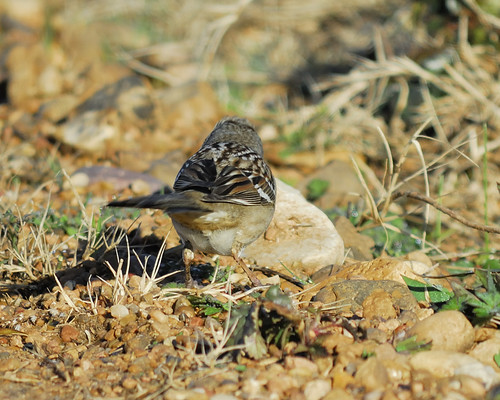tags: White-crowned Sparrow, Zonotrichia leucophrys, birds, mystery bird, bird ID quiz
[Mystery bird] White-crowned Sparrow, Zonotrichia leucophrys photographed at Attwater Prairie Chicken National Wildlife Refuge, Texas. [I will identify this bird for you in 48 hours]
Image: Joseph Kennedy, 25 January 2010 [larger view].
Nikon D200, Kowa 883 telescope with TSN-PZ camera eyepiece 1/400s f/8.0 at 1000.0mm iso400.
This sweet little bird was my "dissertation species" .. can you name it? There are several subspecies as well, each with slightly different habits and ranges .. maybe you can name the subspecies too? (Just in case you are wondering .. no, it's not easy to name the subspecies for this bird, even when you've got a superb image to go from. I can't name the subspecies, although I can make an "edumacated" guess)
Please name at least one field mark that supports your identification.


Field Sparrow? The wing bars and the grayish head.
Noah and dinosaurs
I was going to say sparrow, too, but wasn't sure which one.
it is a sparrow. i'll give you a hint: it's a Zonotrichia sparrow.
(where'd all my sparrow fans disappear to?)
Hi Grrl,
I guess we've been lurking.
My first impression was of a "Zonotrichia" but you know that I have problems with American Buntings, unless it's a Chipping Sparrow. I think it is probably White-crowned but I can't find your research on the net.
I agree with Adrian -- White-crowned. I would guess that this is an immature, as I would expect to see the tail end of the black head stripes from this angle on an adult. What initially threw me was the buff undertail coverts. NatGeo shows this as typical for Z.l. leucophrys, but this is the sort of "off field mark" detail that I don't feel comfortable about in most field guides. On the other hand, the majority of White-crowneds in the east are, I think, leucophrys, so I'll go with that.
This is the first bird call I ever learned to identify. Crow caws, seagulls and the obvious aside, anyhow. I started noticing the distinctive call every spring through summer in the greater Seattle area. They're practically obnoxious and very easily pegged by that call, but I wonder what their numbers are really like because I see the birds themselves far less often than I hear them.
They're cute little beasts though, and all-American, unlike the omnipresent sons-of-bitches passer domesticus.